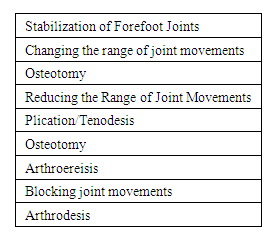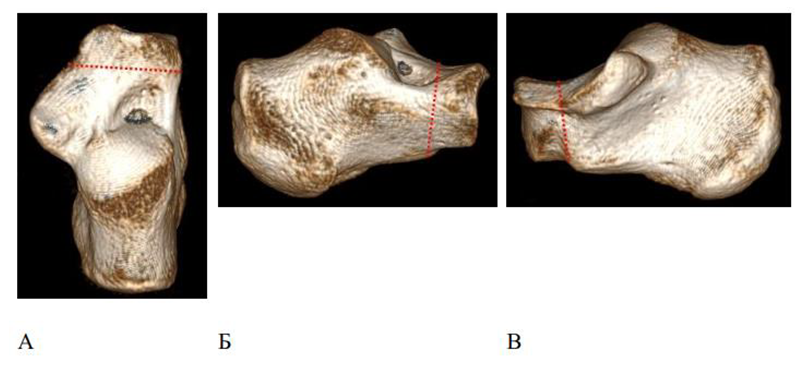| [1] | Dimitrieva A.Yu. Mobile flatfoot in children of primary school age: dis. ... candidate of medical sciences / Dimitrieva Alena Yurievna. - St. Petersburg, 2020. - 203 p. |
| [2] | Kenis, V.M. The relationship between the pain threshold and pain complaints in children with mobile flatfoot / V.M. Kenis, A.Yu. Dimitrieva, A.V. Sapogovskiy // Pediatrics. - 2019. - No. 4. - P. 263-268. |
| [3] | Khramtsov, P.I. Functional stability of vertical posture in children depending on the arch of the feet / P. I. Khramtsov, A. M. Kurgansky // Vestn. Ross. acad. medical sciences. - 2009. - No. 5. - P. 41–44. |
| [4] | Yaremenko D.A. Diagnostics and classification of static foot deformities/D.A. Yaremenko // Orthopedics, traumatology and prosthetics. - 1985. - No. 11. - P.59-67. |
| [5] | Aydın, E. Postural balance control in women with generalized joint laxity /E. Aydın // Turkish Journal of Physical Medicine and Rehabilitation. – 2017. –Vol. 63, N 3. – P. 259–265. |
| [6] | Beighton, P. Ehlers-Danlos syndromes: revised nosology / P. Beighton, A. De Paepe, B. Steinmann [et al.] // AmJMedGenet. – 1998. –Vol. 77. –P. 31-37. |
| [7] | Beighton, P. Ehlers-Danlos syndromes: revised nosology / P. Beighton, A. De Paepe, B. Steinmann [et al.] // AmJMedGenet. – 1998. –Vol. 77. –P. 31-37. |
| [8] | Boffeli, T. J.Cotton Osteotomy in Flatfoot Reconstruction: A Review of Consecutive Cases / Boffeli T. J., Schnell K. R. // The Journal of Foot and Ankle Surgery - 2017, 56(5), 990–995. |
| [9] | Cass, A. D.A Review of Tarsal Coalition and Pes Planovalgus: Clinical Examination, Diagnostic Imaging, and Surgical Planning / Cass, A. D., Camasta, C. A. // The Journal of Foot and Ankle Surgery - 2010, 49(3), 274–293. |
| [10] | Crim, J. Imaging of Tarsal Coalition. / Crim,= J. // Radiologic Clinics of North America - 2008, 46(6), 1017–1026. |
| [11] | De Pellegrin, M.Subtalar extra-articular screw arthroereisis (SESA) for the treatment of flexible flatfoot in children /De Pellegrin M., Moharamzadeh D., Strobl W. M., Biedermann R., Tschauner C., Wirth T. // Journal of Children’s Orthopaedics - 2014, 8(6), 479–487. |
| [12] | Echarri, J.J. The development in footprint morphology in 1851 Congolese children from urban and rural areas, and the relationship between this and wearing shoes / J.J. Echarri, F. Forriol // J Pediatr Orthop B.–2003. –Vol. 12, N2. – P. 141–146. |
| [13] | El, O. Flexible flatfoot and related factors in primary school children: a report of a screening study / O. El, O. Akcali, C. Kosay [etal.] // Rheumatology International. – 2006. –Vol. 26, N 11. – P. 1050-1053. |
| [14] | Evans, A.M. The paediatric flat foot and general anthropometry in 140 Australian school children aged 7 - 10 years / A.M. Evans // J Foot Ankle Res. –2011. –Vol. 4, N 1. – P.12. |
| [15] | Ford, S. E. Pediatric Flatfoot / Ford S. E., Scannell B. P. // Foot and Ankle Clinics - 2017, 22(3), 643–656. |
| [16] | Garcia–Rodriguez, A. Flexible flat feet in children: a real problem? / A. Garcia-Rodriguez, F. Martin-Jimenez, M. Carnero-Varo [etal.] // Pediatrics. – 1999. – Vol. 103, N 6. – P. e84. |
| [17] | Harris, R.I. Hypermobile flat-foot with short tendoachillis / R.I. Harris, T. Beath // Journal of Bone and Joint Surgery (American). –1948. – Vol. 30, N 1. – P. 116-150. |
| [18] | Ker, R.F. The spring in the arch of the human foot / R.F. Ker, M.B. Bennett, S.R. Bibby [et al.] // Nature. – 1987. – Vol. 325, N 6100. – P. 147-149. |
| [19] | Kothari, A. Health-related quality of life in children with flexible flatfeet: a cross-sectional study / A. Kothari, J. Stebbins, A.B. Zavatsky [etal.] // Journal of children's orthopaedics. - 2014. - Vol. 8, N 6. - P. 489-496. |
| [20] | Koutsogiannis, E. Treatment of mobile flat foot by displacement osteotomy of the calcaneus/ Koutsogiannis E. // J Bone Joint Surg Br1971 Feb; 53(1): 96-100. |
| [21] | Sharamonova S.B., Fedorov A.I. Prevention and correction of flat feet in children of preschool and primary school age by means of physical education. - Chelyabinsk: Ural GAFK, 1999. - 112 p. |
| [22] | Eksler A.B., Chechelnitskaya S.M. Changes in the anatomical and functional characteristics of the foot in children with flat-valgus feet under the influence of adaptive physical education / A.B. Eksler, S.M. Chechelnitskaya // Bulletin of the Moscow City Pedagogical University. Series: "Natural Sciences". 2014. No. 3 (15) 2014. P. 111-120. |
| [23] | Yankelevich E.I. Beautiful posture, easy gait. Prevention and correction of posture disorders and flat feet in children and adolescents. - M.: Physical Culture and Sports, 2001. - 96 p. |
| [24] | Aharonson Z. Foot-ground pressure pattern of flexible flatfoot in children, with and without correction of calcaneovalgus / Aharonson Z, Arcan M. Clin Orthop. 1992; 278: 177-182. |
| [25] | Basmajian JV. The Role of Muscles in Arch Support of the Foot an electromyographic study/ J. V. Basmajian, G. Stecko. The Journal of Bone & Joint Surgery. 1963; 45: 1184-1190. |
| [26] | Bertani A. Flat foot functional evaluation using pattern recognition of ground reaction data/ A. Bertani [et al.]. Clinical biomechanics (Bristol, Avon). 1999; 14(7): 484-93. |
| [27] | Bleck EE. Conservative management of pes valgus with plantar flexed talus flexible / E. E. Bleck, U. J. Berzins. Clin. Orthop. 1973; 125: 85. |
| [28] | Brewerton DA. «Idiopathic» pes cavus: an investigation into its aetiology / D. A. Brewerton [et al.]. British medical journal. 1963; 2:659-661. |
| [29] | Cavanagh PR. The arch index: a useful measure from footprints / P. R. Cavanagh, M. M. Rodgers. Journal of biomechanics. 1987; 20(5): 547. |
| [30] | Chang J. H. Prevalence of flexible flatfoot in Taiwanese school-aged children in relation to obesity, gender, and age / J. H. Chang [et.al.]. Eur J Pediatr. 2010; 169(4): 447-52. |
| [31] | Christopher Rose RE. Flat feet in Children: When should they be treated / R. E. Christopher Rose. Flat feet in Children: When should they be treated. 2016; 5(1). |
| [32] | Cicchinelli LD. Analysis of gastrocnemius recession and medial column procedures as adjuncts in arthroereisis for the correction of pediatric pes planovalgus: a radiographic retrospective study / L. D. Cicchinelli [et al.] J Foot Ankle Surg. 2008; 47(5): 385-91. |
| [33] | Cook DA. Observer variability in the radiographic measurement and classification of metatarsus adductus / D. A. Cook [et al.]. Journal of pediatric orthopedics. 1992; 12(1): 86-89. |
| [34] | Cowan DN. Foot morphologic characteristics and risk of exercise-related injury/ D. N. Cowan [et al.]. Archives of family medicine. 1993; 2(7): 773-777. |
| [35] | Doğan A. The results of calcaneal lengthening osteotomy for the treatment of flexible pes planovalgus and evaluation of alignment of the foot / A. Doğan [et al.]. Acta orthopaedica et traumatologica turcica. 2016; 40(5): 356-366. |
| [36] | Echarri JJ. The development in footprint morphology in 1851 Congolese children from urban and rural areas, and the relationship between this and wearing shoes / J. J. Echarri, F. Forriol. Journal of pediatric orthopedics. Part B. 2003; 12(2): 141-146. |
| [37] | Ekcali O, Kosay C, Kaner B, Arslan Y, Sagol E, Soylev S, Iyidogan D, Cinar N, Peker O. Flexible flatfoot and related factors in primary school children: a report of ascreening study. Rheumatol Int. 2016; 26(11): 1050-3. |
| [38] | Evans AM. The flat-footed child — to treat or not to treat: what is the clinician to do? / A. M. Evans. J Am Podiatr Med Assoc. 2008; 98(5): 386-93. |
| [39] | Forriol F. Footprint analysis between three and seventeen years of age / F. Forriol, J. Pascual. Foot & ankle. 1990; 11(2): 101-104. |
| [40] | Franklin J. Obesity and risk of low self-esteem: a statewide survey of Australian children/ J. Franklin [et al.]. Pediatrics. 2016; 118(6): 2481-2487. |
| [41] | García-Rodríguez A. Flexible flat feet in children: a real problem? / A. García-Rodríguez [et al.]. Pediatrics. 1999; 103(6): 84. |
| [42] | Giannini S. Kinematic and isokinetic evaluation of patients with flat foot / S. Giannini [et al.]. Italian journal of orthopaedics and traumatology.1992; 18(2): 241-251. |
| [43] | Giladi M. The low arch, a protective factor in stress fractures: a prospective study of 295 military recruits / M. Giladi [et al.]. Orthop Rev. 1985; 14: 82-84. |
| [44] | Grady JF, Kelly C. Endoscopic gastrocnemius recession for treating equinus in pediatric patients / J. F. Grady, C. Kelly. Clin Orthop Relat Res. 2010; 458(4): 1033-8. |
| [45] | Gutiérrez PR. Giannini prosthesis for flatfoot / P. R. Gutiérrez, M. H. Lara. Foot Ankle Int. 2005; 26(11): 918-26. |
| [46] | Hamel J. Resection of talocalcaneal coalition in children and adolescents without and with osteotomy of the calcaneus. Oper Orthop Traumatol. 2009; 21(2): 180-92. |
| [47] | Harris RI. Hypermobile flat-foot with short tendo achillis / R. I. Harris, T. Beath. The Journal of bone and joint surgery. American volume. 1948; 30A(1): 116-140. |
| [48] | Hayashi B. Gastrocnemius recession: Effective remedy for recalcitrant foot pain / B. Hayashi [et al.] / http://ww/aaas.org/news/bulletin/oct07/clinical4.asp. |
| [49] | Hefti F. Flatfoot / F. Hefti, R. Brunner. Der Orthopäde. 1999; 28(2): 159-172. |
| [50] | Hunt AE. Mechanics and control of the flat versus normal foot during the stance phase of walking / A. E. Hunt, R. M. Smith. Clinical biomechanics (Bristol, Avon). 2014; 199(4): 391-397. |
| [51] | Jerosch J. The stop screw technique--a simple and reliable method in treating flexible flatfoot in children / J. Jerosch, J. Schunck, H. Abdel-Aziz. Foot Ankle Surg. 2009; 15(4): 174-8. |
| [52] | Kanatli U. Gözil R, Besli K, Yetkin H, Bölükbasi S. / U. Kanatli [et al.]. The relationship between the hindfoot angle and the medial longitudinal arch of the foot. Foot Ankle Int. 2016; (27)8: 623-7. |




 Abstract
Abstract Reference
Reference Full-Text PDF
Full-Text PDF Full-text HTML
Full-text HTML